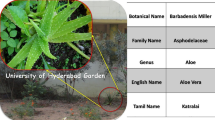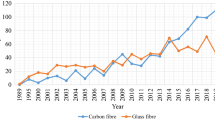Abstract
Present glasses are synthesized by the melt-quench method. The ashes of rice husk and sugarcane leaves are taken to synthesize the present samples. The eggshell powder is used to modify the glass-network and reduced the melting temperature of rice husk ash and sugarcane leaves ash. The as-quenched samples are characterized using different experimental techniques to study their structural and optical properties. The optical band gaps are found in the insulating range, i. e. 3.34–3.72 eV. The as-prepared glasses showed good luminescent properties due to some trace transition elements oxides present in the agro-food wastes. The agro-food wastes could be used as a resource and valuable materials to synthesize value-added engineering materials like glasses. The addition of eggshell powder into the main content showed the blue shift in photoluminescence spectra with enhanced intensity. This property may be exploited to develop UV–visible light-emitting diodes and some other non-linear optical devices.






Similar content being viewed by others
References
Liu N, Huo K, McDowell MT, Zhao J, Cui Y (2013) Rice husks as a sustainable source of nanostructured silicon for high performance Li-ion battery anodes. Sci Rep 3:1–7. https://doi.org/10.1038/srep01919
Mohanta K, Kumar D, Parkash O (2012) Properties and Industrial applications of rice husk: a review. Int J Emerg Technol Adv Eng 2:86–90
Wang Y, Zhao Q, Han N, Bai L, Li J, Liu J, Che E, Hu L, Zhang Q, Jiang T, Wang S (2015) Mesoporous silica nanoparticles in drug delivery and biomedical applications, Nanomedicine Nanotechnology. Biol Med 11:313–327. https://doi.org/10.1016/j.nano.2014.09.014
Abdulrahman I, Tijani HI, Mohammed BA, Saidu H, Yusuf H, Jibrin MN, Mohammed S (2014) From garbage to biomaterials: an overview on eggshell based hydroxyapatite. J Mater Sci 2014:6. https://doi.org/10.1155/2014/802467
Adam F, Nelson J, Khanam Z, Thankappan R, Asri M, Nawi M (2013) Applied surface science utilization of tin and titanium incorporated rice husk silica nanocomposite as photocatalyst and adsorbent for the removal of methylene blue in aqueous medium. Appl Surf Sci 264:718–726. https://doi.org/10.1016/j.apsusc.2012.10.106
Haslinawati MM, Matori KA, Waheb ZA, Sidek HAA, Zainal AT (2009) Effect of temperature on ceramic from rice husk ash. Int J Basic Appl Sci 9:1–3
Lee T, Othman R, Yeoh FY (2013) Development of photoluminescent glass derived from rice husk. Biomass Bioenergy 59:380–392. https://doi.org/10.1016/j.biombioe.2013.08.028
Aktas B, Albaskar M, Yalcin S, Dogru K (2016) Optical properties of soda-lime-silica glasses doped with peanut shell powder. Arch Mater Sci Eng 82:57–61
Firihu MZ (2017) Characteristic of silica xerogel from rice husk ash wastes sintered by microwave and conventional. Pure Appl Chem Sci 5:1–7
Pode R (2016) Potential applications of rice husk ash waste from rice husk biomass power plant. Renew Sustain Energy Rev. https://doi.org/10.1016/j.rser.2015.09.051
Vijayakumar K, Safai PD, Devara PCS, Rao SVB, Jayasankar CK (2016) Effects of agriculture crop residue burning on aerosol properties and long-range transport over northern India: a study using satellite data and model simulations. Atmos Res 178:155–163. https://doi.org/10.1016/j.atmosres.2016.04.003
Chaow-u-thai A, Inthidech S, Rittidech S, Pattiya A (2012) Removal of ash from sugarcane leaves and tops. Int J Bio Sci 2:12–17
Binod P, Sindhu R, Singhania RR, Vikram S, Devi L, Nagalakshmi S, Kurien N, Sukumaran RK, Pandey A (2010) Bioethanol production from rice straw: an overview. Bioresour Technol 101:4767–4774
Rashad A (2016) Cementitious materials and agricultural wastes as natural fine aggregate replacement in conventional mortar and concrete. J Build Eng 5:119–141. https://doi.org/10.1016/j.jobe.2015.11.011
Shrivas A, Ash F (2015) Application of different waste in concrete as a partial replacement of cement coarse aggregate. Int J Sci Tech Eng 2:89–107
Singh M, Siddique R (2013) Resources, conservation and recycling effect of coal bottom ash as partial replacement of sand on properties of concrete. Resources Conserv Recycl 72:20–32. https://doi.org/10.1016/j.resconrec.2012.12.006
Ogunribido THT, MNMGS MTRCN (2011) Potentials of sugar cane straw ash for lateritic soil stabilization in road construction. Int J Sci Emerg Technol 3:102–106
Kumar A, Sengupta B, Dasgupta D, Mandal T, Datta S (2016) Recovery of value added products from rice husk ash to explore an economic way for recycle and reuse of agricultural waste. Rev Environ Sci Biotechnol. https://doi.org/10.1007/s11157-015-9388-0
Anshar M, Ani FN, Kader AS (2016) Electrical energy potential of rice husk as fuel for power generation in Indonesia. ARPN J Eng Appl Sci 11: 3616–3624
Regis M, Leal LV, Galdos MV, Walter A, Oliveira COF (2013) Sugarcane straw availability, quality, recovery and energy use: a literature review. Biomass Bioenerg. https://doi.org/10.1016/j.biombioe.2013.03.007
Nagrale SD, Hajare H, Modak PR (2012) Utilization of rice husk ash. Int J Eng Res Appl 2:1–5
Devi L, Jayasankar CK (2018) Spectroscopic investigations on high efficiency deep red-emitting Ca2SiO4:Eu3+ phosphors synthesized from agricultural waste. Ceram Int. https://doi.org/10.1016/J.CERAMINT.2018.05.003
Baláž M (2014) Eggshell membrane biomaterial as a platform for applications in materials science. Acta Biomater 10:3827–3843. https://doi.org/10.1016/j.actbio.2014.03.020
Oliveira DA, Benelli P, Amante ER (2013) A literature review on adding value to solid residues: egg shells. J Clean Prod 46:42–47. https://doi.org/10.1016/j.jclepro.2012.09.045
Cornejo IA, Ramalingam S, Fish JS, Reimanis IE (2014) Hidden treasures: TURNING food waste into glass. Amer Ceram Soc Bull 93:24–27
Lahl N, Bahadur D, Singh K, Singheiser L, Hilpert K (2002) Chemical interactions between aluminosilicate base sealants and the components on the anode side of solid oxide. Fuel Cells 149:607–614. https://doi.org/10.1149/1.1467945
Jha P, Danewalia SS, Sharma G, Singh K (2018) Antimicrobial and bioactive phosphate-free glass–ceramics for bone tissue engineering applications. Mater Sci Eng C 86:9–17. https://doi.org/10.1016/j.msec.2018.01.002
Lee T, Othman R, Yeoh FY (2013) Development of photoluminescent glass derived from rice husk. Biomass Bioenerg 59:380–392. https://doi.org/10.1016/j.biombioe.2013.08.028
Siegel GJ (1974) Ultraviolet spectra of silicate glasses: a review of some experimental evidence. J Non Cryst Solids 13(74):372–398. https://doi.org/10.1016/0022-309390002-7
Barbieri L, Ferrari AM, Lancellotti I, Leonelli C, Rincòn JM, Romero M (2004) Crystallization of (Na2O–MgO)–CaO–Al2O3–SiO2 glassy systems formulated from waste products. J Am Ceram Soc 83:2515–2520. https://doi.org/10.1111/j.1151-2916.2000.tb01584.x
Chuayjuljit S, Eiumnoh S, Potiyaraj P (2001) Using silica from rice husk as a reinforcing filler in natural rubber. J Sci Res Chula Univ 26:127–138
Wang S (2008) Application of solid ash based catalysts in heterogeneous catalysis. Environ Sci Technol 42:7055–7063. https://doi.org/10.1021/es801312m
Sharma G, Arya SK, Singh K (2018) Optical and thermal properties of glasses and glass-ceramics derived from agricultural wastes. Ceram Int 44:947–952. https://doi.org/10.1016/j.ceramint.2017.10.027
Chandrasekhar S, Satyanarayana KG, Pramada PN, Raghavan P, Gupta TN (2003) Processing, properties and applications of reactive silica from rice husk—an overview. J Mat Sci 38:3159–3168. https://doi.org/10.1023/A:1025157114800
Yasothai R, Kavitha NV (2014) Eggshell waste is a calcium source for layers: review. Int J Sci Environ Technol 3:1465–1471
Singh S, Singh K (2015) Nanocrystalline glass ceramics: structural, physical and optical properties. J Mol Struct 1081:211–216. https://doi.org/10.1016/j.molstruc.2014.10.018
Jha P, Singh K (2015) Effect of MgO on bioactivity, hardness, structural and optical properties of SiO2–K2O–CaO–MgO glasses. Ceram Int 42:436–444. https://doi.org/10.1016/j.ceramint.2015.08.128
Shannon RD (1993) Dielectric polarizabilities of ions in oxides and fluorides. J Appl Phys 73:348–366. https://doi.org/10.1063/1.353856
Shelby JE (2005) Introduction to glass science and technology. Royal Society of Chemistry, Cambridge
Ingwell DOBD (1999) Densities of melts in the CaO–MgO–Al2O3–SiO2 system. Am Mineral 84:465–476
Danewalia SS, Singh K (2016) Magnetic and bioactive properties of MnO2/Fe2O3 modified Na2O–CaO–P2O5–SiO2 glasses and nanocrystalline glass-ceramics. Ceram Int 42:11858–11865. https://doi.org/10.1016/j.ceramint.2016.04.108
Singh K, Bala I, Kumar V (2009) Structural, optical and bioactive properties of calcium borosilicate glasses. Ceram Int. https://doi.org/10.1016/j.ceramint.2009.06.006
Kaur G, Pandey OP, Singh K (2012) Effect of modifiers field strength on optical, structural and mechanical properties of lanthanum borosilicate glasses. J Non Cryst Solids 358:2589–2596. https://doi.org/10.1016/j.jnoncrysol.2012.06.006
Kalampounias AG (2011) IR and Raman spectroscopic studies of sol–gel derived alkaline-earth. Bull Mat Sci 34:299–303
Zamratul MIM, Zaidan AW, Khamirul AM, Nurzilla M, Halim SA (2016) Results in physics formation, structural and optical characterization of neodymium doped-zinc soda lime silica based glass. Res Phys 6:295–298
Danewalia SS, Sharma G, Thakur S, Singh K (2016) Agricultural wastes as a resource of raw materials for developing low-dielectric glass–ceramics. Sci Rep 6:24617. https://doi.org/10.1038/srep24617
Fluegel A (2007) Thermal expansion calculation of silicate glasses at 210. Most 60:1–25
Kubelka P, Munk F (1931) Ein Beitrag zur Optik der Farbanstriche. Zeitschrift für Tech Phys 12:593–601. https://doi.org/10.4236/msce.2014.28004
Kaviyarasu K, Manikandan E, Kennedy J, Jayachandran M, Maaza M (2016) Rice husks as a sustainable source of high quality nanostructured silica for high performance Li- on… Rice husks as a sustainable source of high quality nanostructured silica for high performance Li-ion battery requital by s. Adv Mats Let. https://doi.org/10.5185/amlett.2016.6192
Salh R (2011) Defect related luminescence in silicon dioxide network: a review. Cryst Silicon Prop Uses. https://doi.org/10.5772/22607
Imai H, Arai K, Imagawa H, Hosono H, Abe Y (1988) Two types of oxygen-deficient centers in synthetic silica glasses. Phys Rev B 38:772–775
Acknowledgements
The authors are very grateful to Santhosh Kumar Mahadevan and Dr. Jayant Kolte for their valuable suggestion and SAI labs, TIET, Patiala for providing characterization facilities. Authors are thankful to Dr. Sanjay Sharma (Modi College, Patiala) for their help in FTIR results.
Author information
Authors and Affiliations
Corresponding author
Additional information
Publisher’s Note
Springer Nature remains neutral with regard to jurisdictional claims in published maps and institutional affiliations.
Rights and permissions
About this article
Cite this article
Sharma, G., Singh, K. Recycling and utilization of agro-food waste ashes: syntheses of the glasses for wide-band gap semiconductor applications. J Mater Cycles Waste Manag 21, 801–809 (2019). https://doi.org/10.1007/s10163-019-00839-z
Received:
Accepted:
Published:
Issue Date:
DOI: https://doi.org/10.1007/s10163-019-00839-z




